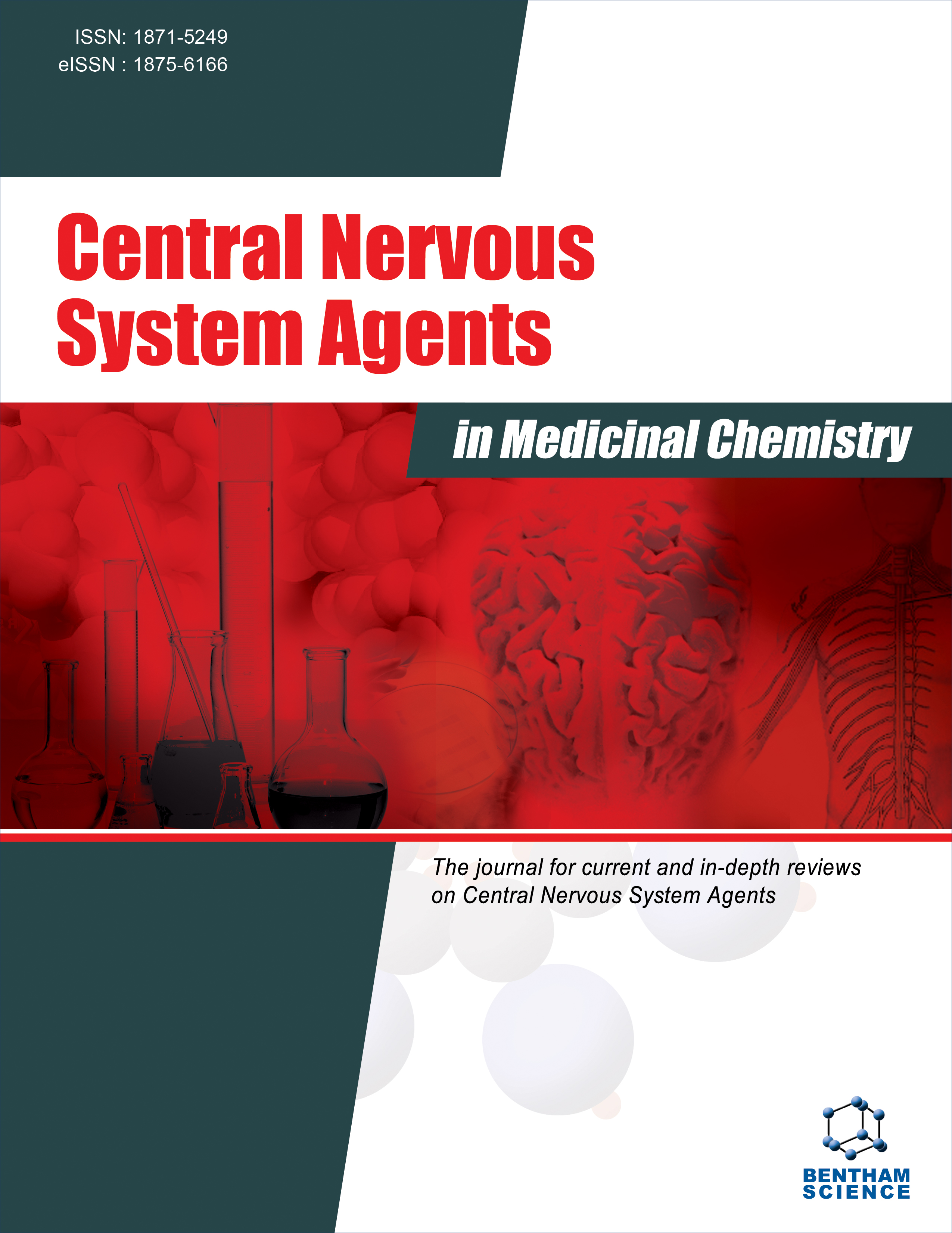- Home
- A-Z Publications
- Central Nervous System Agents in Medicinal Chemistry (Formerly Current Medicinal Chemistry - Central Nervous System Agents)
- Previous Issues
- Volume 17, Issue 2, 2017
Central Nervous System Agents in Medicinal Chemistry (Formerly Current Medicinal Chemistry - Central Nervous System Agents) - Volume 17, Issue 2, 2017
Volume 17, Issue 2, 2017
-
-
Role of the α7 Nicotinic Acetylcholine Receptor and RIC-3 in the Cholinergic Anti-inflammatory Pathway
More LessAuthors: Treinin Millet, Papke L. Roger, Nizri Eran, Ben-David Yael, Mizrachi Tehila and Brenner TalmaBackground: The nicotinic acetylcholine receptor (nAChR) gene family encodes for subunits of acetylcholine gated ion channels. These receptors are expressed widely and have many functions: They mediate excitation at neuro-muscular junctions. Nicotinic Acetylcholine Receptor: In the central nervous system nAChRs have been implicated in memory, cognition, and addiction. And in non-excitatory cells they regulate diff Read More
-
-
-
Alpha-7 Nicotinic Receptors in Nervous System Disorders: From Function to Therapeutic Perspectives
More LessAuthors: Antonella De Jaco, Laura Bernardini, Jessica Rosati and Ada Maria TataBackground: The α7 nicotinic receptor consists of identical subunits and is one of the most abundant acetylcholine receptors in the mammalian central nervous system. However its expression is also found in the peripheral nervous system as well as in the immune system and various peripheral tissues. Nicotinic Receptors: They are involved in the regulation of several activities ranging from excitatory neurotransmissio Read More
-
-
-
Cholinergic System and Neuroinflammation: Implication in Multiple Sclerosis
More LessAuthors: Maria Di Bari, Giovanni Di Pinto, Marcella Reale, Guadalupe Mengod and Ada Maria TataBackground: Multiple sclerosis (MS) is an inflammatory and neurodegenerative disease of the central nervous system (CNS) characterized by leucocytes infiltration, demyelination, axonal degeneration and neuronal death. Although the etiology of MS is still unkwon, inflammation and autoimmunity are considered to be key players of the disease. Nervous System: The severe alterations affecting the nervous system co Read More
-
-
-
Anticancer, Antioxidant and Cytotoxic Potential of Thymol in vitro Brain Tumor Cell Model
More LessAuthors: Elanur Aydın, Hasan Turkez, Sener Tasdemir and Fazıl HacımuftuogluBackground: Thymol (THY), which is a monocyclic monoterpene, found in oil of thyme various other kinds of plants. Until today, although different biological properties of THY have been indicated, its neurological toxicity has never been investigated. Method: In this study, in vitro antiproliferative (by 3-(4,5 dimetylthiazol-2-yl)-2,5 diphenlytetrazolium bromide (MTT) test), genotoxic (by single cell gel electrophoresis (SCGE)) and oxid Read More
-
-
-
Synthesis and Antioxidant Properties of Novel Memantine Derivatives
More LessBackground: Medicinal chemistry methodologies are presently used to develop multifunctional molecules which simultaneously reduce oxidative stress, excitotoxicity, metal dyshomeostasis, and neuroinflammation that characterize neuropathological conditions, such as Alzheimer’s Disease. Results: Memantine (MEM) derivatives 1-6 were designed and synthesized as novel multifunctional entities with antioxidant and neuropro Read More
-
-
-
Effect of MRJF4 on C6 Glioma Cells Proliferation and Migration
More LessBackground: MRJF4, a novel haloperidol metabolite II prodrug, was obtained through the esterification of the secondary hydroxyl group of haloperidol metabolite II with 4-phenylbutyric acid. The activities of (±)-MRJF4 and its two enantiomers [(+)-MRJF4 and (-)-MRJF4] as tumor specific inducers of pro-apoptotic genes were evaluated on malignant C6 glioma cells. In particular, changes in Nf-ΚB signaling pathway, activity Read More
-
-
-
Piroxicam: Source for Synthesis of Central Nervous System (CNS) Acting Drugs
More LessBackground: The use of central nervous system (CNS) acting drugs in the management of neuro degenerative and psychiatric problems cannot be overemphasized. Therefore, the chemical structure of piroxicam can be modified to yield new CNS stimulants and depressants that can be of great benefit to man and animals. Methodology: Acetylcholine has Methyl - Oxygen-Oxygen (M-O-O) and Nitrogen (N) functional groups which Read More
-
-
-
Stimulated CB1 Cannabinoid Receptor Inducing Ischemic Tolerance and Protecting Neuron from Cerebral Ischemia
More LessAuthors: Quankun Zhuang, Cailing Dai, Linglong Yang, Huimin Wen, Hongyun Wang, Xiaoxue Jiang and Yuyang ZhangBackground: It is reported that endogenous cannabinoids can cause vasodilation and bradycardia. They have anti-inflammatory effect and protect endothelial cells from injury, therefore they have potential application prospect in the prevention of cardio-cerebrovascular diseases. However, the mechanisms of the neuroprotection mediated by cannabinoid 1 receptors (CB1Rs) have not been uncovered in detail. Methods: Nearly o Read More
-
-
-
How Valid is Placebo in the Indian Setting?
More LessAuthors: Himanshu Sharma and Bharti SharmaBackground: The Placebo is defined as an inert substance with a potent therapeutic effect. Its effect is attributed to its psychological and neurobiological effect. Its use in Psychiatric drug practice, drug trials and clinical practice is common, especially in India. Currently there is a debate whether to use it or not as there are ethical, moral and legal issues. Also, its mechanism of action is not known. Discussion: The Indian P Read More
-
-
-
Design, Synthesis and Molecular Docking Studies of New Potential Piperazine Derivatives as Cognition Enhancers
More LessAuthors: Chhanda C. Danta and Poonam PiplaniBackground: In 2016, the statistical reports stated that Alzheimer is not just memory loss but it kills and has become the 6th leading cause of death. The number of dementia patients is increasing rapidly and expected to rise to 131.5 million by 2050. Still there is not a drug candidate that can cure the cognitive deficits completely. Objective: Series of novel piperazine derivatives have been designed, synthesized and evaluated f Read More
-
Volumes & issues
-
Volume 25 (2025)
-
Volume 24 (2024)
-
Volume 23 (2023)
-
Volume 22 (2022)
-
Volume 21 (2021)
-
Volume 20 (2020)
-
Volume 19 (2019)
-
Volume 18 (2018)
-
Volume 17 (2017)
-
Volume 16 (2016)
-
Volume 15 (2015)
-
Volume 14 (2014)
-
Volume 13 (2013)
-
Volume 12 (2012)
-
Volume 11 (2011)
-
Volume 10 (2010)
-
Volume 9 (2009)
-
Volume 8 (2008)
-
Volume 7 (2007)
-
Volume 6 (2006)
Most Read This Month
Article
content/journals/cnsamc
Journal
10
5
false
en


